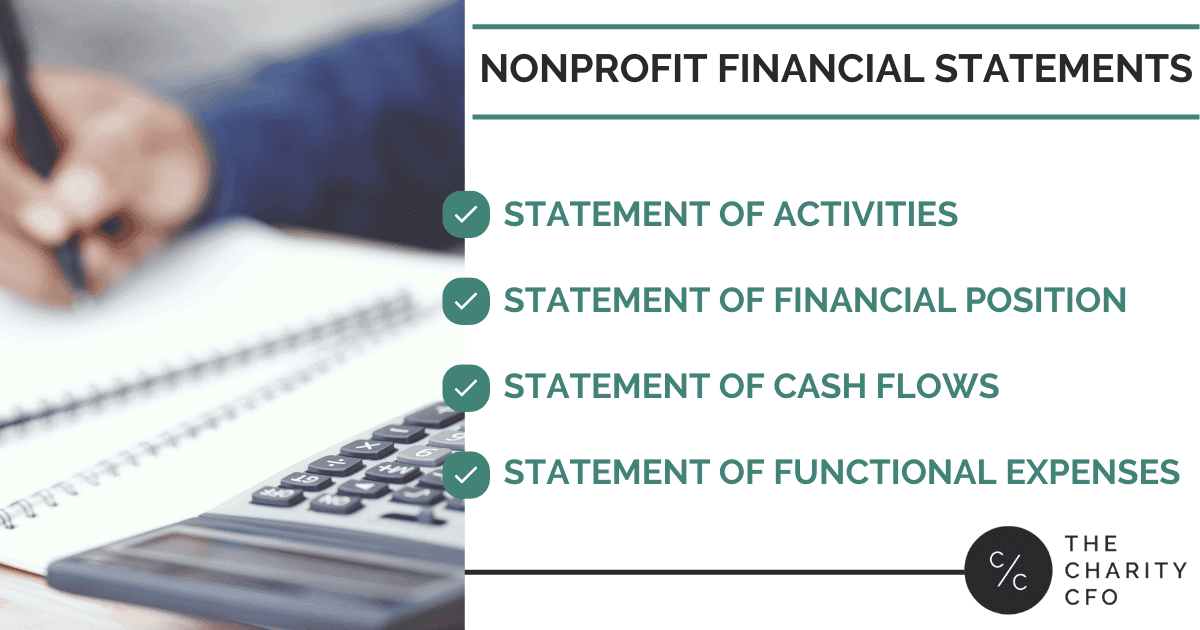From Necessary Evil to Mission Fuel: The Strategic Role of Nonprofit Financial Statements
Nonprofit financial statements. Is this just a necessary evil just to meet compliance requirements, and make sure there’s enough cash in the bank? Or can your financial statements be a lens to view your organization and fuel the mission?
In this post, we’ll walk through the most important financial statements, and explain the strategic benefit you can gain by pulling the maximum value from the data.

Nonprofit Financial Statements
You are likely familiar with the different nonprofit financial statements that are typically included in a reporting package:
- Statement of Activities
- Statement of Financial Position
- Statement of Cash Flows
- Statement of Functional Expenses
But we’d like to dive beyond the surface. This article explores the multifaceted uses of these financial statements and highlights their significance in enabling financial transparency, informed decision-making, and organizational effectiveness for nonprofit entities.
Remember, these uses are not mutually exclusive, and some applications may overlap across the categories. The categorization of uses may vary depending on the specific context and goals of your nonprofit organization.
Statement of Activities
Financial Uses
- Assessing Revenue Sources: Analyze the various revenue sources of a nonprofit, such as donations, grants, program fees, and investment income. This information is crucial for financial planning, budgeting, and identifying potential areas of revenue growth.
- Evaluating Expenses: Evaluate the expenses incurred by the nonprofit, such as program expenses, administrative costs, fundraising expenses, etc. It enables financial analysis to identify cost-saving opportunities, manage expenses, and ensure efficient resource allocation.
Strategic Uses
- Financial Planning: Provides insights into the financial health of the organization. Can help in identifying trends, forecasting future revenues and expenses, and making informed decisions about resource allocation, fundraising efforts, and program expansion.
- Performance Evaluation: By comparing the revenues and expenses on the Statement of Activities with the nonprofit’s strategic goals and objectives, it becomes a valuable tool for assessing performance. It allows management to measure the effectiveness of programs, evaluate cost-efficiency, and make strategic adjustments to enhance overall performance.
Operational Uses
- Program Evaluation: Evaluate the financial performance of individual programs or activities conducted by the nonprofit. By analyzing revenues and expenses associated with each program, it helps in assessing program viability, resource allocation, and identifying areas for improvement or expansion.
- Stakeholder Communication: Serves as a transparent communication tool for stakeholders, including donors, board members, and grant-making organizations. It provides an overview of the nonprofit’s financial activities, highlighting its financial stability, sustainability, and the impact of its programs.
Statement of Financial Position
Financial Uses
- Assessing Financial Health: Provides information about its assets, liabilities, and net assets, allowing stakeholders to evaluate solvency, liquidity, and overall financial position.
- Analyzing Financial Structure: By presenting the organization’s assets and liabilities, the statement assists in analyzing the financial structure, including the composition of assets (e.g., cash, investments, receivables) and liabilities (e.g., accounts payable, loans). This analysis supports decision-making regarding debt management, investment strategies, and asset allocation.
Strategic Uses
- Financial Planning and Budgeting: Provides insights into the organization’s available resources and financial capacity, enabling strategic decision-making regarding resource allocation, capital investments, and long-term financial sustainability.
- Assessing Financial Viability: By examining the organization’s assets, liabilities, and net assets, the statement helps provide information on the organization’s ability to meet its financial obligations, support ongoing programs, and sustain its mission over the long term.
Operational Uses
- Managing Cash Flow: By analyzing cash and cash equivalents, accounts receivable, and accounts payable, it helps monitor liquidity, plan for short-term financial needs, and ensure the smooth operation of the organization.
- Evaluating Working Capital: Supports operational decision-making by evaluating the organization’s working capital and helps determine whether the nonprofit has sufficient working capital to cover day-to-day operational expenses and short-term obligations.
Statement of Cash Flows
Financial Uses
- Cash Position Assessment: Assessing cash inflows and outflows, allows stakeholders to evaluate the availability and adequacy of cash resources, which is crucial for financial planning and decision-making.
- Cash Flow Analysis: Assists in analyzing the sources and uses of cash within the organization. It provides insights into cash generated from operating activities, investing activities, and financing activities. This analysis supports financial analysis, budgeting, and investment decision-making.
Strategic Uses
- Strategic Planning: Contributes to strategic planning by providing information on the organization’s cash flow patterns. It helps identify trends, fluctuations, and cash flow drivers, which are important for long-term financial sustainability and strategic decision-making.
- Capital Expenditure Planning: Assists in planning for capital expenditures and major investments. By examining the cash flows related to investing activities, it helps assess the organization’s ability to fund capital projects, acquire assets, and allocate resources strategically.
Operational Uses
- Cash Management: Aids in cash management by providing insights into the organization’s cash inflows and outflows on a detailed operational level. It helps monitor cash flow cycles, anticipate cash needs, and manage working capital efficiently.
- Liquidity Assessment: Supports operational decision-making by evaluating the liquidity of the nonprofit. It provides information on the organization’s ability to meet short-term obligations and fund day-to-day operations.
Statement of Functional Expenses
Financial Uses
- Expense Analysis: Helps analyze and categorize expenses by their functional nature, such as program services, management and general, and fundraising. By providing a breakdown of expenses, it allows stakeholders to assess cost structures, monitor expenditure trends, and identify areas for cost management and optimization.
- Financial Reporting: Provides a comprehensive view of the organization’s expenses. It ensures compliance with reporting standards and provides transparency to stakeholders about how resources are allocated and utilized.
Strategic Uses
- Program Evaluation: Aids in evaluating the financial performance and effectiveness of individual programs or services offered by the nonprofit. It helps assess the allocation of resources, cost-efficiency, and the impact of programs on the organization’s overall mission and strategic objectives.
- Decision-Making: By analyzing expenses across different functional categories, the statement supports strategic decision-making. It helps identify areas where resources can be allocated or reallocated to align with the nonprofit’s strategic priorities and maximize the organization’s impact.
Operational Uses
- Budgeting and Planning: Supports operational budgeting and planning by providing insights into historical expense patterns. It helps in setting realistic budgets for various functional areas, monitoring actual expenses, and ensuring effective resource allocation.
- Cost Control and Efficiency: Assists in monitoring and controlling expenses on an operational level. By analyzing expenses within different functional categories, it helps identify cost-saving opportunities, manage spending, and improve operational efficiency.
Nonprofit financial statements fuel your mission
Financial statements play a crucial role in the financial management and governance of nonprofit organizations. By leveraging these financial statements and their diverse uses, nonprofit organizations can pursue their mission with confidence.
Additionally, adhering to compliance obligations reinforces credibility and trust among donors, board members, and regulatory bodies. As financial reporting standards and accountability expectations continue to evolve, nonprofit organizations must prioritize accurate and transparent financial reporting practices to thrive in an increasingly complex landscape. By harnessing the power of financial statements, nonprofits can navigate challenges, drive mission-driven impact, and foster sustainable growth for the betterment of their communities.
The Charity CFO specializes in nonprofit accounting and bookkeeping. If you want to dig deeper, you can learn more in our Financial Statement Guide here.







